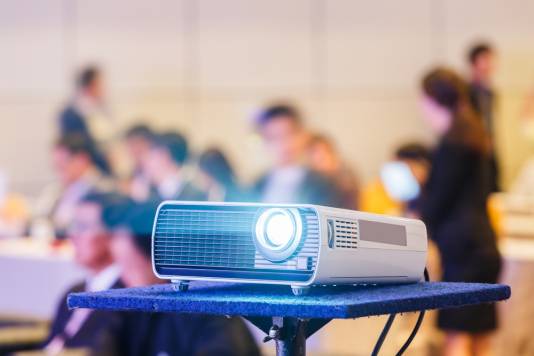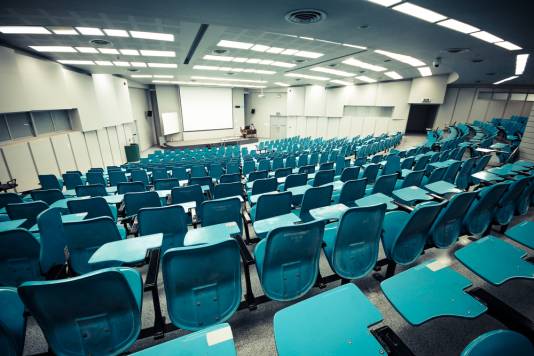Many people may remember the old over-head projectors (OHPs) which schools used back in the seventies, eighties and nineties. Dodgy colours, suspect focusing and teachers who were the opposite of tech-savvy!
The great news is that the projectors of today are much more advanced and can play a much more important role in education than ever before. Today, their reach extends way beyond the classroom or lecture theatre. They are cost-efficient, reliable and extremely high quality. They allow teachers to achieve maximum impact – more so than the largest TV on the market can.
They can now be easily integrated with an array of new technologies for example, they can be used as recording devices so that revision material can be used at any time in the future.
Projectors enable teachers to focus more on visually engaging projects, which helps to increase attention spans and, effectively, enables students to absorb more information. With the internet and social media chipping away at children’s ability to focus and concentrate, it’s more important than ever to keep lessons engaging.

Laser Projectors
We’ll look at the benefits of projectors inside the classroom shortly, but their impact outside the classroom can be dramatic. To capture lectures, high-quality laser projectors can be used in conjunction with pan-tilt cameras and audio systems to record all manner of presentations. These can then be uploaded and accessed online by students.
You might think that having high-resolution projectors and recording the lectures would result in less students attending, but educational establishments have seen numbers increase because students can concentrate fully on the teaching without having to slavishly take notes.
With projectors, we’re talking big images, and there is no other display technology which offers such good value in terms of cost relative to display quality and size. Especially with larger class sizes, a front-of-class display – usually a projector – is almost a necessity.

What can projectors actually do?
Let’s look at a quick example of what you can do with a classroom projector. Let’s imagine you’re in class and everyone is getting out their textbooks as there’s an image you want to discuss. In a normal class, everyone would be searching for the image, and as you discuss the topic, it’s a fair bet that half of the class will still be looking down at their book during the discussion and won’t be properly engaged. However, if you have a projector, you can easily display the image for everyone at the front of the classroom. You’ll now have the whole class concentrating together without distractions. Their attention will be in the right place, so that you can run your class more effectively.
As technology – and teaching methods – change, many classes (especially ones which are short on space) now have different AV requirements. Rather than just one large display in a classroom, there can be a central projector supported by smaller screens around the room.
High quality, relatively low-cost projectors in lecture theatres has brought increased benefits following the emergence of laser technology. Demand is growing as projectors have finally caught up with HD TVs. 5,000+ lumen projectors are perfect for universities and all forms of lecture theatres.

Interactive Projectors
Cameras can be used with projectors to bring learning benefits. These allow teachers to share passages of text, detailed diagrams and 3D objects with the whole class – but additionally, teachers and students can add notes to an image captured by the cameras and capture lessons as video clips to be used later. This is way beyond what the traditional projectors could ever dream of!
And just in case you were wondering how projectors perform in different lighting conditions: No, you don’t have to black out the whole room now, they project in daylight! And costs are lower too! Laser technology provides around 20,000 hours of high-quality, virtually maintenance-free performance.
When a projector is delivering teaching materials, it has to be viewable by everybody in the classroom or lecture theatre. It has to be bright enough, the image has to be large enough and at the correct height for everybody to be able to read the content.
A short throw / ultra-short throw or ceiling mounted projector is preferable for in the classroom. Dual projectors are also becoming more popular as they offer added flexibility and are ideal for a side-by-side presentation where teachers want reference material beside the main picture. Like any technology, if you’re not using it every day it can seem daunting. If you’re a teacher thinking about the possibilities, then just speak to one of Ebuyer’s specialists who can guide you through the process of working out which type of equipment is best for the space and numbers you have in your classroom or lecture theatre.
Multiple Sources
Projectors are an inclusive tool in the classroom, enabling teachers to draw on multiple sources during a lesson, and to engage students in a more engaging way. Learning generally is dependent on the creativity of the teacher and the way they share tools and content which is used in the lesson. As ever, technology will play a large part in the lives of children and even more so when they find themselves in the workplace.

Creativity is vital – but did you know that there are now projectors which can function outside in standard daylight? This is another growing trend as schools continually look to be creative in – and outside of – the classroom. Projecting outside can be extremely helpful for lessons about the environment, geography, and in fact any outside activity! And, just in case you were wondering about how this works technically, it all connects wirelessly!
The teacher can engage with students and take photos of their work and instantly have it projected on to a screen or whiteboard. You can take a screenshot and email it immediately to a student for reference. When used to their full potential, projectors bring subjects to life and help make the content much more memorable to students, which is the aim, after all.
It really is the case that young people have developed a need for – and expect -visual stimulation. They can easily switch off if they are not stimulated. A projector makes education exciting, engaging and interesting – so switch on your projector to get them focussed.
Projectors for improved learning
Let’s take a more in-depth look at how using a projector in education can help improve learning. The advancement in technology means that students no longer have to crowd around a shared desktop PC or shuffle their chairs nearer to a TV monitor to view any multimedia presentations. A single projector has the power to engage students and keep their attention for longer periods of time.
What are the key benefits of using projectors in education? Let’s take a look!
More efficient note taking
All classrooms can benefit from having a projector, and taking notes is one area where you’ll see a vast improvement. How many times do students fail to write down notes properly because they couldn’t write down something fast enough? And students are often seen leaning over to someone’s book to see what they’ve missed. This can lead to extra time being spent outside the lesson ‘catching up’ or not getting the work completed at all, which could lead to problems later in tests and exams.
A visual representation of text at the front of class (alongside the teacher) will solve these note-taking issues. After all, if students aren’t taking proper notes, they’re not going to learn what they should. This defeats the object of the class!

Better presentations
Students can get their message across much more effectively using an interactive resource such as a projector. They can create exciting ways to deliver informative presentations rather than using just speech.
Better student presentations can also aid the engagement of the other students in class. If students lack confidence and struggle when talking to a teacher, then a projector has the power to help personal development too. If students can deliver effective and interactive presentations, this will help them gain understanding of the subject. This can greatly help students gain confidence and, let’s face it, once they enter the working environment, being able to present will be a positive thing for possible employers.
Interactive lesson plans
Innovation can only be a good thing, can’t it? Teachers already have a wealth of knowledge, but using new technology can introduce an array of exciting ways to educate their classes. Interactive lesson plans are a great way to utilise the new breed of projectors. Getting students to come up to take part in an activity or even showing a video exploring another country – using visual content, lesson plans can be exciting, interactive and inclusive. They could use Google Earth for geography or stream videos to find out information needed for a history lesson. The possibilities are endless.
Greater Teaching Versatility
The projector removes the connection between teachers and dry erase boards! By using projectors, teachers can use videos, slides and images to clarify points made in class. The projector can also be used to display any web content you need for all your classes. Instead of thirty students trying to access the website on their individual computers, you have instant information and the class haven’t drifted off in the process.

Better Use of Class Time
Projectors are great for freeing up valuable class time. While writing a note on a board as well as erasing all the information takes time, just a simple click of a button is enough to switch over to the next PowerPoint needed for the lesson. By using projectors, teachers save time, giving them more quality time to actually teach!
Here are just a few things you can do with your projector to help in class!
Media Resources
Documentaries, news clips and interviews offer rich learning opportunities – streaming video can help make connections between class work and ‘real life’ easier for students. Try TED talks; you can search by topic at ted.com.
Travel the World
*Visit papapaalive.org for a child’s eye view of everyday life from a school in Ghana. These are videos made by the children of Fairtrade cocoa farmers. Each clip is about five minutes long, includes subtitles, and is supported by teaching resources. It’s so easy now to connect with classrooms all over the world – use Skype or Google+ to chat with other classes about a variety of topics.
Take A Visit!
*Visit museums without even leaving the classroom, thanks to virtual tours such as those of the National Gallery nationalgallery.org.uk/visiting/virtualtour/#/central-hal or the Louvre louvre.fr/en/visites-en-ligne
Start Projecting!
At slideshare.net you’ll find endless ways of using your projector, because this site is brimming over with presentations, infographics, documents and inspiring videos created from around the world.
Take a look at Ebuyer’s range of projectors for education here. And remember, we have a team of specialists who will be able to answer all of your questions if you need a bit more information.





















